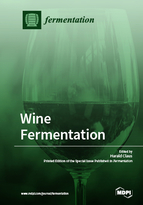Wine Fermentation
A special issue of Fermentation (ISSN 2311-5637). This special issue belongs to the section "Fermentation for Food and Beverages".
Deadline for manuscript submissions: closed (15 December 2018) | Viewed by 90135
Special Issue Editor
Interests: wine microbiology; phenoloxidases; biotechnical enzymes; bioethanol; bioremediation
Special Issues, Collections and Topics in MDPI journals
Special Issue Information
Dear Colleagues,
Life is an evolutionary process that is subjected to permanent alterations with the need for adaptions to changing conditions. The same is very true for the traditional art of wine fermentation. In the last few years, wineries have been facing new challenges due to current market demands for the creation of products exhibiting more individual flavors. Distinct climate changes provoke the search for grape varieties with specific features, such as convenient maturation times, enhanced tolerances towards dryness and osmotic stress, as well as resistance against invasive phytopathogenic organisms.
Innovative winemaking techniques and new yeast strains will contribute to solve some of these problems, such as increased sugar concentrations at grape maturity. Non-conventional Saccharomyces species like S. uvarum, S. kudriavzevii and their natural hybrids exhibit good fermentative capacities producing wines with lower ethanol and higher glycerol concentrations. In addition, they may be useful to avoid stuck fermentations as they can grow at deeper temperatures even under nitrogen limitations and display a more fructophilic character. Current biological approaches are in progress for wine deacidification using Saccharomyces yeasts in addition to the classical lactic acid bacteria Oenococcus oenii or Lactobacillus plantarum.
Non-Saccharomyces yeasts, considered essentially as “wild” spoiling microorganisms in the past, are estimated beneficial today as they improve the wine aroma profile when grown in controlled mixed starter fermentations together with S. cerevisiae. Artificial hybrids as well as collection of adapted isolates from various ecological niches all over the world will further extend winemakers yeast toolkit, allowing specific fermentations.
Not only causing gustatory pleasures and sometimes stimulating effects, moderate wine consumption has also been recognized as beneficial to human health in many clinical studies. Especially polyphenols in red wine are associated with positive antioxidant and cardiovascular properties. Modern winemaking techniques will take care to maintain high levels of these beneficial compounds, but at the same time to minimize concentrations of risky wine ingredients such as sulfites, biogenic amines, heavy metals, mycotoxins or proteins with allergenic potential.
The application of technical enzymes in wine fermentations offer many advantages such as speeding up settling and clarification processes, increased juice yields, higher contents of phenolic compounds and aroma precursors, improved color stability, as well as wine filterability. They are effective, specific and convenient to use, and it can be expected that the search for enzymes from grape-associated yeasts with improved characteristics will continue.
This Special Issue comprises actual studies addressing some problems and solutions for environmental, technical and consumer challenges of “Wine Fermentation” in the 21st century.
Dr. Harald Claus
Guest Editor
Manuscript Submission Information
Manuscripts should be submitted online at www.mdpi.com by registering and logging in to this website. Once you are registered, click here to go to the submission form. Manuscripts can be submitted until the deadline. All submissions that pass pre-check are peer-reviewed. Accepted papers will be published continuously in the journal (as soon as accepted) and will be listed together on the special issue website. Research articles, review articles as well as short communications are invited. For planned papers, a title and short abstract (about 100 words) can be sent to the Editorial Office for announcement on this website.
Submitted manuscripts should not have been published previously, nor be under consideration for publication elsewhere (except conference proceedings papers). All manuscripts are thoroughly refereed through a single-blind peer-review process. A guide for authors and other relevant information for submission of manuscripts is available on the Instructions for Authors page. Fermentation is an international peer-reviewed open access monthly journal published by MDPI.
Please visit the Instructions for Authors page before submitting a manuscript. The Article Processing Charge (APC) for publication in this open access journal is 2600 CHF (Swiss Francs). Submitted papers should be well formatted and use good English. Authors may use MDPI's English editing service prior to publication or during author revisions.
Keywords
- wine aroma
- starter cultures
- mixed fermentations
- stuck fermentations
- yeast hybrids
- grape resistance
- microbial ecology
- enzymes
- malolactic fermentation
- human health






